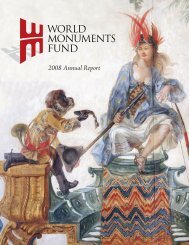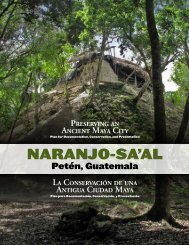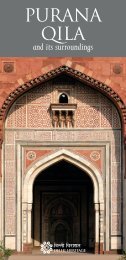Summary of the Proceedings and Papers Presented at - World ...
Summary of the Proceedings and Papers Presented at - World ...
Summary of the Proceedings and Papers Presented at - World ...
You also want an ePaper? Increase the reach of your titles
YUMPU automatically turns print PDFs into web optimized ePapers that Google loves.
The archaeological research in <strong>the</strong> Casa dei Postumii<br />
<strong>and</strong> its surroundings was executed as a joint<br />
research project <strong>of</strong> <strong>the</strong> German Archaeological Institute,<br />
Rome, <strong>and</strong> <strong>the</strong> Bavarian Academy <strong>of</strong> Sciences.<br />
While this work was completed in 2002, studies about<br />
<strong>the</strong> long-term protection <strong>of</strong> <strong>the</strong> site <strong>and</strong> its interpret<strong>at</strong>ion<br />
(musealizzazione) have not yet been conducted. The conserv<strong>at</strong>ion<br />
<strong>of</strong> Cubiculum 5 was sponsored by Studiosus Reisen,<br />
Munich.<br />
Cubiculum 5, on <strong>the</strong> west side <strong>of</strong> <strong>the</strong> <strong>at</strong>rium, is <strong>the</strong> only<br />
room in <strong>the</strong> house th<strong>at</strong> has preserved its decor<strong>at</strong>ion fairly<br />
intact. In 1997, it showed all <strong>the</strong> signs <strong>of</strong> <strong>the</strong> repe<strong>at</strong>ed quick<br />
<strong>and</strong> preliminary repairs undertaken since its excav<strong>at</strong>ion in<br />
1860. First <strong>of</strong> all, <strong>the</strong> conserv<strong>at</strong>ion program called for <strong>the</strong> reduction<br />
<strong>of</strong> humidity inside <strong>the</strong> walls, <strong>the</strong> prevention <strong>of</strong> large<br />
areas <strong>of</strong> plaster becoming detached from <strong>the</strong> walls <strong>and</strong> <strong>the</strong><br />
fur<strong>the</strong>r deterior<strong>at</strong>ion <strong>of</strong> <strong>the</strong> colored co<strong>at</strong>ing <strong>of</strong> <strong>the</strong> frescoes.<br />
The three most important aspects <strong>of</strong> our agenda were to<br />
make sure <strong>of</strong> <strong>the</strong> total reversibility <strong>of</strong> all techniques <strong>and</strong> m<strong>at</strong>erials<br />
applied, second, avoid any work th<strong>at</strong> could cause fur<strong>the</strong>r<br />
damage to <strong>the</strong> decor<strong>at</strong>ion, <strong>and</strong>, third, to cre<strong>at</strong>e a more<br />
homogeneous impression for <strong>the</strong> modern viewer.<br />
A major result <strong>of</strong> our work is th<strong>at</strong> <strong>the</strong> room can now be<br />
appreci<strong>at</strong>ed as an aes<strong>the</strong>tic whole. Consequently, <strong>the</strong> small<br />
Dionysian pictures are recognizable as part <strong>of</strong> a particular<br />
sp<strong>at</strong>ial concept, reflecting <strong>the</strong> need for a certain st<strong>and</strong>ard <strong>of</strong><br />
living <strong>and</strong> represent<strong>at</strong>ion in <strong>the</strong> Casa dei Postumii.<br />
italiano<br />
Casa dei Postumii (VIII 4, 4.49) <strong>and</strong> its<br />
Insula: Present St<strong>at</strong>e <strong>and</strong> Future Prospects<br />
for Conserv<strong>at</strong>ion <strong>and</strong> Present<strong>at</strong>ion<br />
by Jens-Arne Dickmann & Felix Pirson (in collabor<strong>at</strong>ion with Letizia Abbondanza,<br />
Corinna Brückener, Janet Haberkorn <strong>and</strong> Barbara Schick)<br />
The protective ro<strong>of</strong><br />
The starting point for <strong>the</strong> development <strong>of</strong> a protective<br />
ro<strong>of</strong> for <strong>the</strong> Casa dei Postumii was <strong>the</strong> need to cover Cubiculum<br />
5 <strong>and</strong> its freshly-conserved decor<strong>at</strong>ion. As <strong>the</strong> design<br />
<strong>of</strong> <strong>the</strong> ro<strong>of</strong> is based on a modular structure, <strong>the</strong> ro<strong>of</strong> can be<br />
exp<strong>and</strong>ed in future. In addition to <strong>the</strong> need for a modular<br />
structure, <strong>the</strong> following principles determined <strong>the</strong> design <strong>of</strong><br />
<strong>the</strong> protective cover:<br />
n complete reversibility,<br />
n no use <strong>of</strong> ancient walls as support for modern<br />
construction,<br />
n no re-mortaring <strong>of</strong> ancient masonry,<br />
n no reconstruction <strong>of</strong> any kind,<br />
n a ro<strong>of</strong> as a ‘light ceiling’ such as used in modern<br />
museums,<br />
n a rel<strong>at</strong>ively fl<strong>at</strong> surface, <strong>and</strong><br />
n a minimum number <strong>of</strong> steel pillars.<br />
The general conviction behind <strong>the</strong>ses principles is th<strong>at</strong> an<br />
archaeological monument should be preserved as much as<br />
possible without altering its original archaeological st<strong>at</strong>e. A<br />
clear <strong>and</strong> comprehensible interpret<strong>at</strong>ion <strong>of</strong> <strong>the</strong> archaeological<br />
monument for <strong>the</strong> modern visitor should be achieved via<br />
o<strong>the</strong>r media, such as explan<strong>at</strong>ory panels <strong>and</strong> audio- or video-guides,<br />
ra<strong>the</strong>r than permanent reconstructions, as <strong>the</strong>se<br />
render contemporary scholarly views absolute <strong>and</strong> deprive<br />
subsequent gener<strong>at</strong>ions <strong>of</strong> <strong>the</strong> chance to study <strong>the</strong> monument<br />
with new questions <strong>and</strong> methods.
















